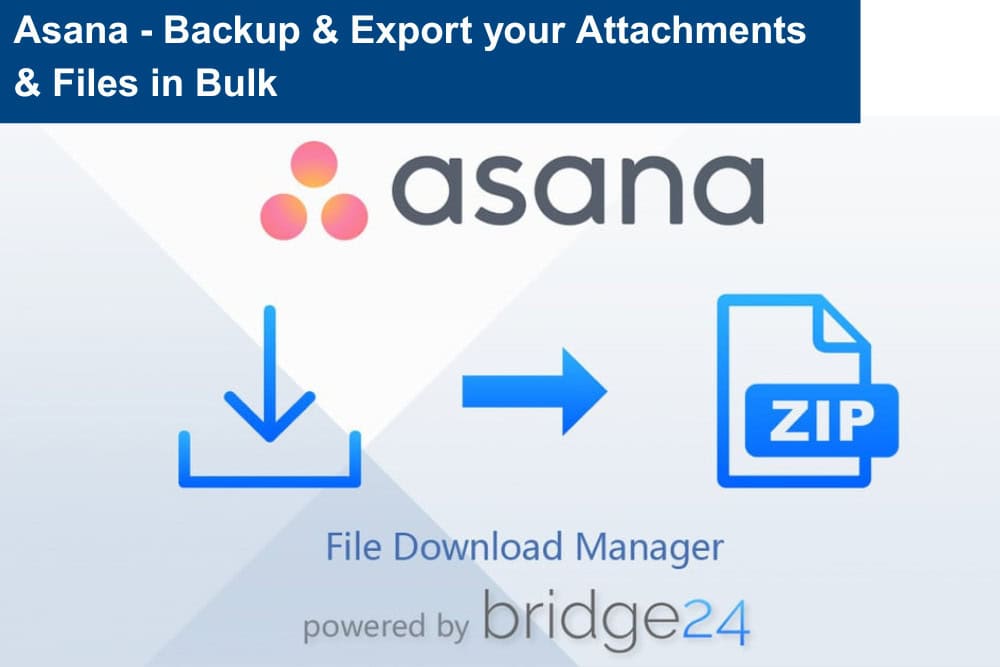
If you’re an Asana user who’s ever needed to download files or attachments in bulk, you know it can be a bit of a hassle. Clicking through individual tasks just to grab each file is time-consuming, especially when managing complex projects or wrapping up deliverables at scale. That’s why Bridge24 is excited to introduce one of the most requested features by Asana users: the File Download Manager. With this new capability, users can easily download all attachments across tasks, projects, or custom searches — in bulk — without breaking a sweat.
Whether you’re looking to back up image files from design tasks, save legal documents for compliance reasons, or simply store everything locally, this tool makes the entire process streamlined and intuitive. Let’s explore how the File Download Manager works and what makes it such a valuable addition to your workflow.
What Can You Do with the File Download Manager?
Bridge24’s File Download Manager offers unmatched flexibility for exporting files from Asana. You can:
- Download attachments from individual tasks.
- Download files from a filtered search of tasks (e.g., tasks with specific tags or completion status).
- Export attachments from one project or multiple projects at once.
- Retrieve documents from archived, completed, or ongoing tasks.
- Generate structured or flat zip folders with a full log of file activity.
This means that whether you’re preparing monthly reports, backing up project data for client handoff, or migrating task assets to a different platform, the File Download Manager ensures you can retrieve every file quickly and efficiently. Even better? It’s optimized for performance. The tool can handle everything from a single image to gigabytes of files across several projects without crashing or slowing down your workflow.
Getting Started with the File Download Manager
1) Use Active Search Results
The File Download Manager integrates seamlessly with the Grid view in Bridge24. To begin:
- Start by creating a search using the Quick Links or within the Grid view.
- Apply filters to show only the tasks you want to retrieve attachments from. For instance, filter by due date, project name, tags, assignee, or task status (e.g., only completed tasks).
- Make sure the Attachments column is visible. You can customize columns using the Show/Hide button at the top right.
- Once you’ve curated your list, go to the Export dropdown menu and choose Attachments under the File Export options.
This step helps you refine your download, ensuring you only pull the files you need — no extra clutter, no unnecessary zip files.
2) Access the Download Manager
Once you click on the Attachments Export option, the Download Manager window opens. This is your command center for managing how your files are structured, compressed, and handled. From here, you can configure settings, monitor progress, and review completed downloads.

3) Set Up Your Zip Folder Preferences
The Download Manager gives you full control over how the downloaded files are organized and packaged. Under the Options section, you’ll see several customizable settings:
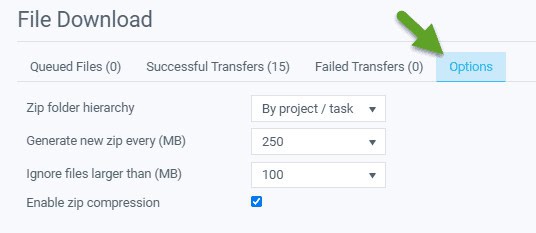
Zip Folder Hierarchy
You can choose how the internal structure of your zip file should be organized:
- By Task: Groups attachments by their respective tasks.
- By Project: All files from the same project are placed together.
- By Project and Task: Creates a nested folder structure for deeper organization.
- Flat (None): All attachments are placed in a single-level folder.
This is particularly useful when you need to retain context. For example, if you’re sharing a folder with a client and want them to see how files relate to individual tasks or phases.
Generate New Zip Every (MB)
Need to manage large file downloads? Set a max size limit (up to 500MB) for each zip file. Once a zip reaches this limit, the system will automatically create a new one and continue downloading. This helps keep your files manageable and easier to share or upload to cloud storage.
Ignore Files Larger Than (MB)
You can choose to skip downloading attachments above a certain size threshold. These files are sent to the Failed Transfers section for manual review later. This feature is perfect if you only need documents and want to exclude large media files, or if you’re working with limited bandwidth.
Enable Zip Compression
Want to reduce file size for faster download? Enable this option to apply compression to your zip files before download begins. It’s a handy option for teams working remotely or on slower internet connections.
4) Start the Download
Once your settings are configured, simply click Start. The system begins collecting and downloading the attachments based on your search filters and zip preferences. This automation allows you to stay productive while the files are packaged in the background.
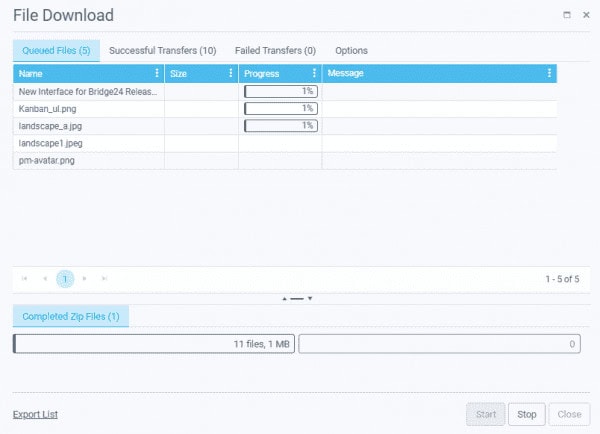
5) Monitor Transfer Status
After initiating the download, you can monitor every step:
- Queued Transfers: Files scheduled and waiting for download.
- Successful Transfers: Files that were downloaded without issues.
- Failed Transfers: Files that were too large, missing, or encountered errors.
The system will display status messages so you can easily identify issues and resolve them, like manually downloading a large video file that didn’t fit into a zip folder.
Additional Features That Make a Difference
Add More Columns
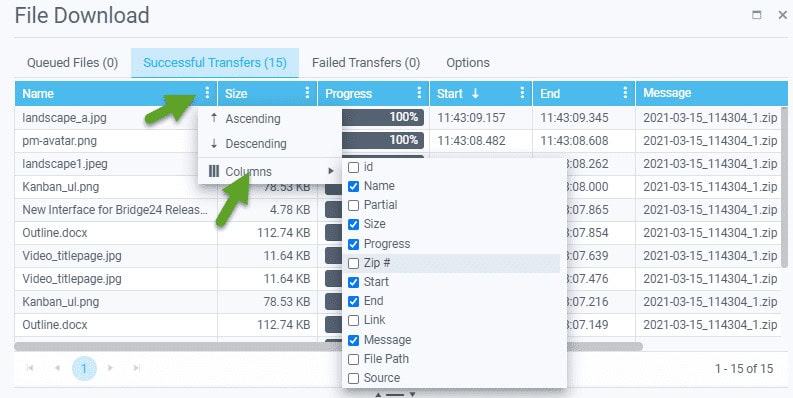
Want to keep track of additional metadata during download? You can display more columns in the grid, such as assignee, tags, or due dates, which can then be included in the downloadable file log. This helps with audits, documentation, and future reference.
Punctual Download from Grid or Edit Panel
Sometimes, you only need files from one task. The good news is you don’t need to go through the full search and export process. You can access the File Download Manager directly from the Grid view, right in the Attachments field for an individual task. This makes on-the-fly file retrieval simple and fast.
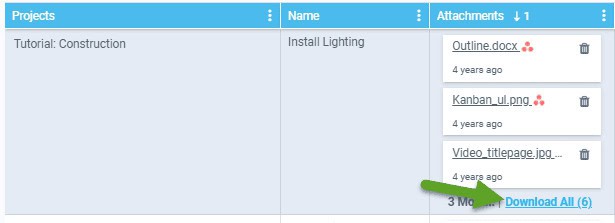
Download Index List
For users who want a full snapshot of what’s being downloaded, there’s an option to download an index XLS file. This spreadsheet includes a list of all files in the current download queue. It’s located at the bottom left of the Download Manager and is great for tracking progress or sharing with teammates.
Download Log File
Once the download is complete, you can also retrieve a download log file via the Summary popup. This Excel file includes all the indexed data from your zip file, such as task IDs, file names, sizes, and transfer status. Perfect for archiving, accountability, or compliance purposes.
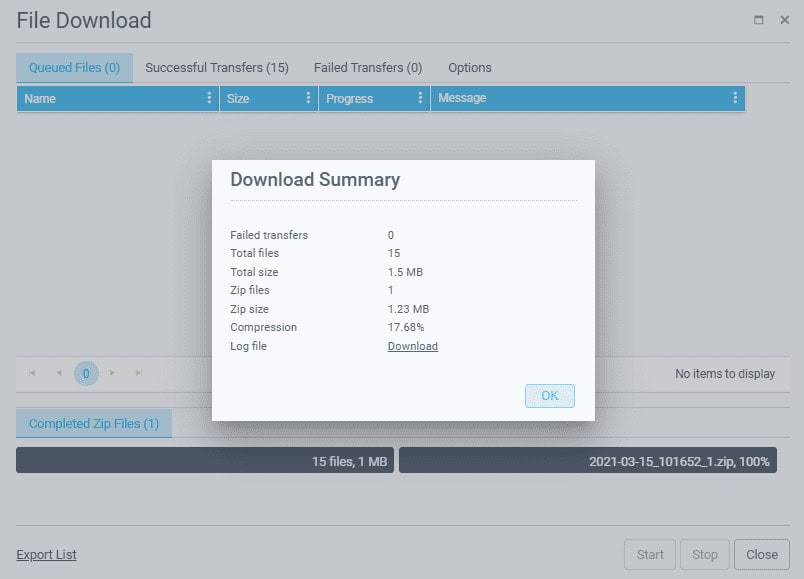
This log file includes all information and indexed data of the downloaded Zip file in XLS format.
Benefits of Using the File Download Manager
1. Time-Saving
The ability to download multiple files at once significantly reduces the time spent on administrative tasks. Teams can focus on more strategic activities instead of manually managing file downloads.
2. Improved Organization
The customizable Zip folder hierarchy ensures that downloaded files are well-organized and easy to locate. This is particularly beneficial for teams that handle complex projects with multiple layers of tasks and subtasks.
3. Enhanced Collaboration
By providing a centralized tool for file downloads, the File Download Manager facilitates better collaboration among team members. Everyone has access to the same set of files, ensuring consistency and alignment.
4. Data Security and Backup
Regularly downloading and backing up files ensures that critical data is not lost due to technical issues or accidental deletions. The File Download Manager makes it easy to maintain secure backups of all project-related files.
5. Scalability
The tool is robust enough to handle everything from a few attachments to large-scale downloads involving hundreds of files. This scalability makes it suitable for teams of all sizes and industries.
Use Cases for the File Download Manager
1. Archiving Completed Projects
Once a project is completed, teams often need to archive all related files for future reference. The File Download Manager simplifies this process by allowing you to download all attachments associated with a project in one go.
2. Preparing for Audits
For organizations that need to comply with regulatory requirements, maintaining detailed records is essential. The File Download Manager ensures that all necessary files are readily available for audits.
3. Transitioning Between Tools
If your team is transitioning from Asana to another project management tool, the File Download Manager can help you export all attachments for seamless migration.
4. Managing Client Deliverables
For agencies and freelancers, delivering files to clients is a routine task. The File Download Manager makes it easy to compile and send all relevant files in an organized manner.
Final Thoughts
The new File Download Manager from Bridge24 adds serious firepower to your Asana workflow. By enabling bulk download of attachments with robust customization options and full tracking logs, it fills a long-standing gap for many project managers, team leads, and freelancers. Whether you’re preparing for client handoff, conducting end-of-month backups, or just trying to stay organized, this tool makes your job much easier.
With detailed options like folder hierarchies, file-size filters, and log tracking, you get professional-grade export control without needing technical expertise. If you’re an Asana power user, now’s the time to put this feature to work.
Suggested articles:
- Charts by Custom Fields for Asana and Trello
- Asana – Export Tasks and Subtasks to Excel and CSV
- Asana vs Basecamp vs Trello Comparison
Peter Kanai is a Google-certified freelance writer with over a decade of experience crafting high-quality content for business websites, blogs, and SEO & email marketing campaigns. His on-demand writing services are all about helping businesses expand their online presence and achieve their objectives. With a proven track record in delivering results-driven content, Peter is the go-to freelance writer for business owners seeking a strategic partner to help them grow their brand online.